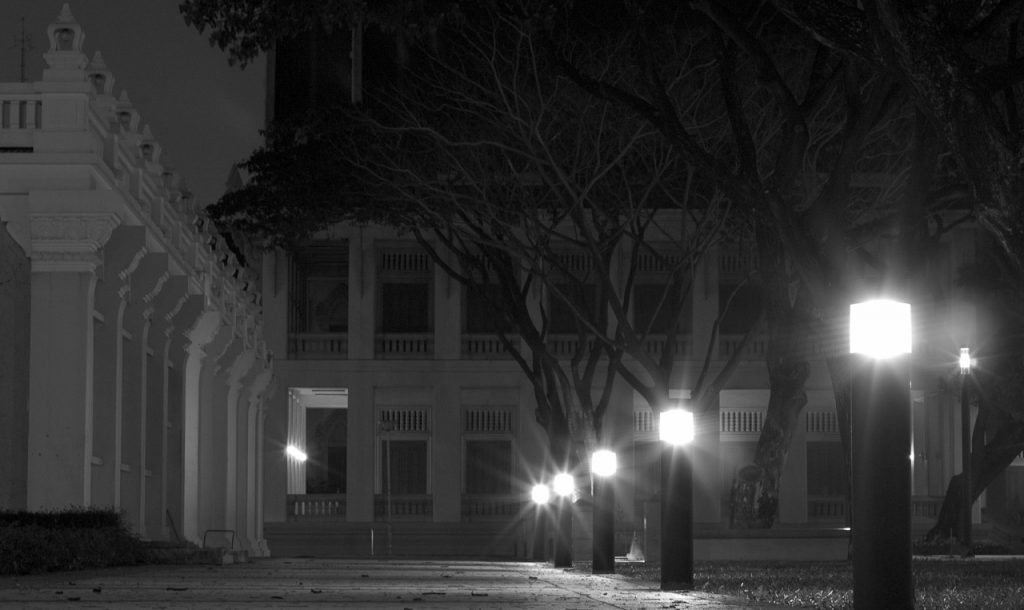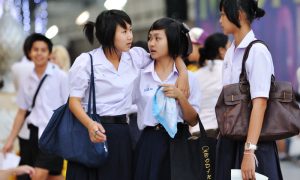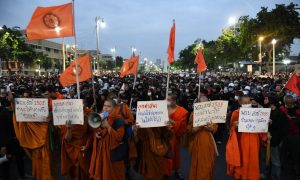Rain was pouring on 14 August and Chulalongkorn University had threatened to punish any student who gathered at the Faculty of Arts. Even so, thousands met in support of students who had set up a protest stage to stake 3 demands. The first related to the dissatisfactory quality of education during the pandemic. The second pertained to the fickleness of the university, which at first had given permission to the gathering but then changed its mind. The third were criticisms that the university’s greedy capitalist practices place profit above the livelihoods of both its students and the local people who live in the areas surrounding the campus. While the demands of students have received some coverage from media, the grievances of the ordinary people who live on the land owned by the university—grievances which have existed almost since the university’s establishment—are mostly overlooked. As students opposed to the injustices associated with the gentrification of Chula, we believe their voices should be heard.
Chulalongkorn has always had the image of Thailand’s most conservative university, but we students who study here are the opposite. Chualongkorn’s student body has throughout all periods of history always included large numbers of progressives and students mobilising to demand social justice, especially in our current cohort. From our perspective, Chulalongkorn is a capitalist institution hidden under the guise of respectability. Chulalongkorn has the appearance of a modern educational institution, but in reality it seeks to generate the highest possible profit without mind for fairness towards its students and local tenants. To do so, it relies on legitimacy rooted in its oldness as an institution and historical relationship with the monarchy. As the following case studies show, Chula’s methods involve exploiting leases as bargaining chips by reducing the length of rental contracts, increasing rent or terminating contracts altogether. These tactics push out tenants, making room for the arrival of expensive and more “sophisticated” stops instead.
The Chao Mae Tubtim Shrine
The history of this Chinese shrine stretches back to the reign of Rama V, when Chinese immigrants began to accumulate positions of financial status in Thailand. The shrine’s incense burner was bestowed by Rama VI, a token from the funeral ceremony of Rama V in 1911, and there is evidence that Rama V himself once visited the shrine. When Chulalokorn University was first built, the land was rented from the King until ownership was transferred to the university during the reign of Rama VI in 1939.
From 1917, the land on which the Chao Mae Tubtim Shrine resides was rented from Chula. Conflict between the local Chinese community and the new controllers of the land emerged when Chula initiated plans to evict the traditional occupants of the land to modernise the area and residences. The villagers refused to leave, until a large fire in 1960 forced their relocation. The Chao Mae Tubtim Shrine was all that remained of the community. But in 1970, the devotion of the villagers and sponsorship from wealthy patrons led to the renovation of the shrine into an even larger edifice. Chinese communities returned and began engaging in the business of repairing cars and selling spare parts.
In recent years however, the communities surrounding the shrine have had their contracts terminated en masse, leaving the shrine in a solitary state. In their place, Chula allowed a car park business to rent the land for profit until this year, when it terminated the contract with the intention of using the land—including that where the Chao Mae Tubtim Shrine resides—to build condominiums both for student dormitories and for renting out to the general public. The university submitted notices ordering the shrine-keepers to move out by June.
A movement opposed to the destruction of Sino-Thai history and culture emerged. A hashtag #savetheChaoMaeTubtimshrine arose, along with protests at the entrance of the shrine. Students and the public petitioned the national parliament’s committee on religion, leading to the shrine becoming a matter of debate in the legislature. Students also attempted to raise public interest in the shrine by organising celebrations of the shrine’s 50 anniversary.
Chula’s response was to promise to collect and preserve artefacts of the shrine, such as the incense burner of Rama V. It pledged to fund a redesign of the shrine and its relocation to a new and near site. However, students and the public remained concerned by the absence of any public hearing to consult the local community, as well as the university’s rather humorous assertion of ownership over artefacts such as the incense burner which is a relic of the family which maintains the shrine—evidence, they ventured, of the university’s failure to recognise the importance and complexity of cultural practices such as ancestral worship. They also pointed out that the proposed new site did not have adequate facilities for the traditional Chinese opera performances regularly staged at the shrine.
Later district officials revealed that Chula had not sought permission to build the new edifice, as is required by law. These events fueled suspicions that the assurances that the shrine would be relocated were mere lip service which the university had no intention of fulfilling.
While the resistance forced Chula to temporarily delay its destruction of the shrine, the university changed tact and resorted to the threat of lawsuits to harass students and supporters of the shrine, ordering all to vacate by 31 August. It also surrounded the shrine with plants to hide the appearance of a shrine, while preparing for the build by setting up residences for construction workers around the shrine. These were psychological tactics aimed at delivering a message that resistance is futile. Still, students and large numbers of the general public continue to hope that their activism will compel Chula to compromise and allow for the co-existence of the shrine alongside the new condominiums.
Chamchuri Square
Chamchuri Square is a commercial centre that was built in the 1960s, attached to Samyan MRT station and on land owned by Chulalongkorn University. In June this year, more than 10 vendors from Chamchuri made headlines when they delivered a petition to Princess Sirindhorn requesting assistance. The vendors described the effects of the COVID-19 pandemic, claiming they no longer had lost the income to pay the rent at Chamchuri but that Chula had provided little assistance.
Once again, the grievances are long standing. Relations between vendors at Chamchuri and the university stirred significant online attention in 2019 when the former, many operating small kiosks selling clothing, protested by sleeping outside Chulalongkorn University’s property management office to demand an extension to their leases and a meeting with the director. The director declined to meet. Among the vendors was an 85-year-old auntie living at the massage shop where she worked. When the owner of the shop was notified of the auntie’s participation in the protest by central staff at Chumchuri Square, she was evicted from the shop. These events popularised the hashtag #Chulakillingvendors.
In 2018, a group of vendors filed a complaint accusing the university management of exploiting their lack of knowledge about their rights under the law to raise profit. This complaint was followed by a hike in rent at Chamchuri by some 200%. Vendors were also banned from selling wares near the base of escalators on the basis that administrators viewed the sight as unseemly. These actions affected the income of the vendors, who again demanded a meeting with administrators. Negotiations went nowhere, even though a survey conducted by students found that 90% of customers believed that the vendors should be allowed to stay.
Under pressure from students and the public, Chulalongkorn agreed to provide vendors space in a new facility with the same rent rates as before. However, when the parties came to sign the contract for the new space, Chula insisted the university would not sign until the existing contract was annulled. The vendors feared that if they agreed to terminate the contract, Chula would backtrack on the promise of a new contract. In the end, a new contract was not signed. Vendors have filed a case at the Administrative Court to intervene, though Chula filed a counter civil suit alleging the vendors are on private property without permission. The cases are currently under deliberation.
Divest Chula
Chulalongkorn’s gentrification is also threatening other cultural institutions and spaces where people make their living. 5 July marked the last day of film screenings at the Scala Theatre, the only remaining art deco theatre in Thailand. In 2017, Scala was saved from having its lease terminated by a campaign by movie lovers and the general public, though it began paying rent to Chula at a hiked rate. Not long before the lease was due to expire in 2020, COVID-19 compelled the owners to close the theatre anyway and return the land. People are now concerned over what Chula will do with the unique institution, especially after the Vice-Chancellor gave an interview to the Thai press asserting that the theatre is “not as old as Wat Phra Kaew” and has nothing so worthy of preservation.
Suanluang Square was also a source of controversy 3 years ago. Suanluang Square was a space that was advertised by the university as prime real estate that would draw heavy foot-traffic from students. The university also promised a marketing campaign to attract students to the area. But the entrepreneurs who flocked found these promises wanting. They university had neglected to advise them of roadwork and problems with the electricity supply in the area. No marketing campaign emerged. A large number of shops made a loss and closed their businesses, despite signing 10-year leases.
Netiwit (one of the authors), as a former President of the Student Council, once invited the tenants on Chulalongkorn’s land to a forum in the student council’s meeting room. Holding this event was cited as one reason for the deduction of behaviour points that led to Netiwit’s notorious expulsion from his position.
All of Chulalongkorn’s actions are supported by a discourse of “advancement.” In the case of the Chao Mae Tubtim Shrine, for example, officials claim that the use of smoke in worship is an unsanitary and harmful practice. Under the current Chancellor’s master plan, the area surrounding the university will become a “smart city” that requires the eviction of large numbers of people currently residing there. Villagers are discouraged by the fight against powerful capitalist forces and the legitimacy that the university derives from the monarchy (the university falls back on the narrative that Rama VI bestowed it the land.)
To attain a university that is just, we must imagine a university that is just. We believe that we should embark on a “Divest Chula” campaign to compel Chulalongkorn University step away from development investments that are destroying the environment and the livelihoods of the people, as proposed by Pitch Pongsawat. Students and those affected by gentrification should have a say in the decisions of the university. Chula staff, current students, alumni and tenants must jointly imagine a vision of what the university should be and the city that they would like to live in, while placing pressure on administrators to face up to the suffering that has come from development without consultation.
 Facebook
Facebook  Twitter
Twitter  Soundcloud
Soundcloud  Youtube
Youtube  Rss
Rss 


